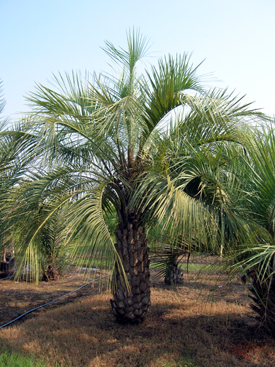Shopping Cart
(0) - $0.00Buy Wholesale Pindo Palm / Butia Capitata Specimen Palm Trees
 The Pindo palm grows slowly and propagates well from the seed. This species originates from South America, on the mountains of Brazil, Argentina and Uruguay. These are the places that reflect best the attitude of this palm tree, as it is sufficiently tolerant to salt and needs partial to full Sun exposure.
The Pindo palm grows slowly and propagates well from the seed. This species originates from South America, on the mountains of Brazil, Argentina and Uruguay. These are the places that reflect best the attitude of this palm tree, as it is sufficiently tolerant to salt and needs partial to full Sun exposure.
Once the seed is planted, there are not too many recommendations to do: the Butia Capitata is easy to grow and does not need much care. For a better chance of success, it is advisable to wait untile the fruit is ripe before gathering it, then it has to be planted as soon as possible in fast-drening, sterile soil. When planting the seed, it is important to remove its hard pit because it can compromise the success of germination. Once the Jelly Palm grows up, some pruning is necessary to groom the dead fronds which the palm does not shed on its own.
The fruits of the Pindo Palm tree tend fall quite easily and come apart on hard surfaces, so it is better to plant the Jelly Palm in a spot where the surrounding 10 feet are covered with grass. Once the palm is grown and its jelly is ready, you will be able to taste its wonderful flavor or just to watch it enriching the landscape.
The Pindo palm will surprise you with its jelly!
Can you think of a delicious jelly that tastes like a banana and pineapple mix? Well, the Butia Capitata (also know as Pindo palm) is a particular palm tree species that can provide you this incredibly tasty fruit, and you don't need to live in a tropical place to see it in your landscape. It is also know as Jelly Palm and can be grown in climates where the temperature goes down to 5 Fahrenheit degrees: for this reason the Butia Capitata is planted in regions like the Florida Panhandle.
